The post Shoulder Injuries appeared first on MetaMed.
]]>The shoulder is a complex joint, made up of many small muscles (rotator cuff, NOT rotor cuff) that all have a crucial role to play. ‘Crucial’ because the joint is so mobile and has little in the way of supporting ligaments, so the muscles have to be strong to stop your arm flapping about in the wind. If one of these muscles is out of kilter, you are more susceptible to injury and on-going pain. So, a quick anatomy lesson.
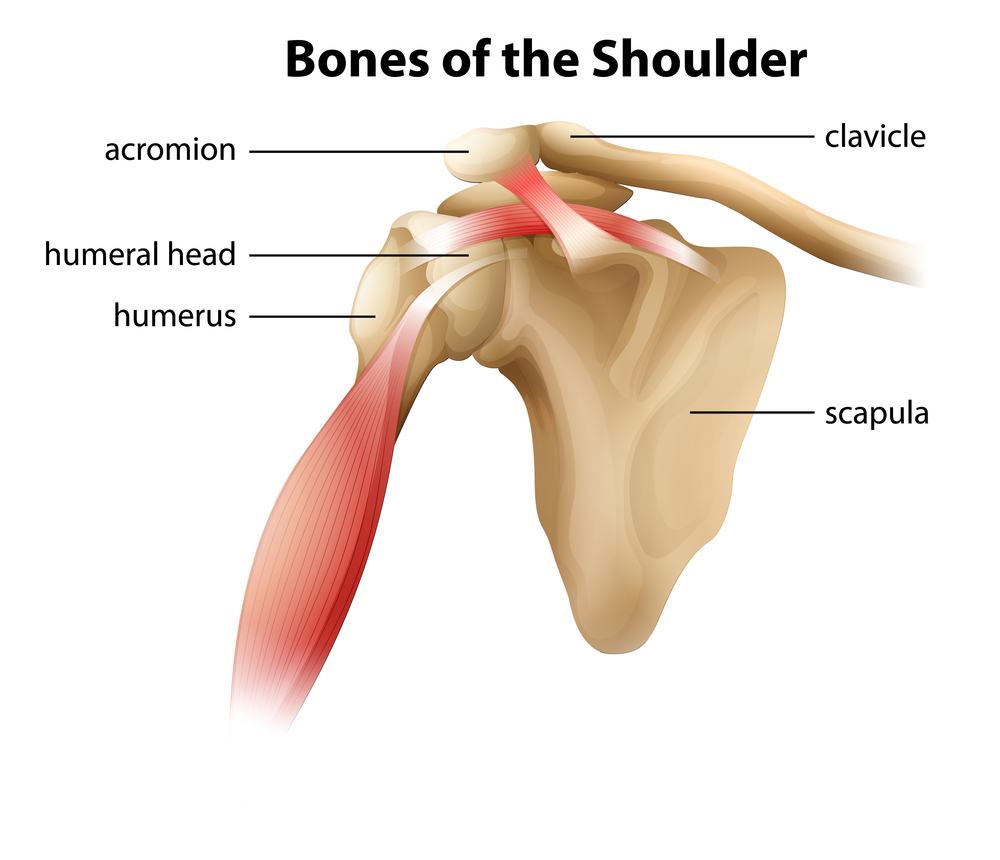
Shoulder anatomy 101
BONES: The shoulder complex is made up of 4 main bones, your humerus, scapula, clavicle and sternum. These combine to make 4 joints that all affect how your arm moves.
LIGAMENTS: The ligaments in the shoulder are small, this allows us increased mobility but sacrifices stability.
MUSCLES: This infamous structure is a collection of 4 muscles: subscapularis, infraspinatus, supraspinatus and teres minor. Good names huh? That’s why we call it the rotator cuff… These muscles are located on the back of your shoulder, with your pectoralis major and deltoid supporting the front.

Rotator cuff tear
What it is – The four muscles that make up the rotator cuff are responsible for keeping the ‘ball in the socket’ and assists in moving your arm. The leading cause of shoulder pain and disability, rotator cuff tears are common in sportspeople and those who do a lot of overhead work. They can be from traumatic injuries or from micro-tears that build up over time and lead to degenerative changes.
What it feels like – pain at night, with overhead activities, weakness and stiffness in the shoulder. Difficulty raising your arm, compensating by hiking through your upper traps in your shoulder. Pain can also radiate down the arm and into the neck.
Treatment
Manual therapy – works on muscle tension that may be affecting the position and mobility of the shoulder blade and humerus causing increased pain at the area. Exercises to strengthen the un-injured muscles and increase stability. Once the injured tendon has healed, focus is put on regaining the ability to activate and strengthen that muscle.
Medical – surgery to reattach the tendon, for complete or large partial tearsonly. This requires a referral to a specialist which your osteopath can organise. Receiving medical treatment before surgery is always a good option to improve your surgery outcomes. Surgery will also depend on how much you use your shoulder in work and sports. Over time your body can compensate even if a muscle or tendon has completely ruptured.
Other – ice/heat, rest, time.
Rotator cuff tendinopathy:
What it is – every muscle is connected to bone via a tendon. Tendinopathy occurs when there is a period of overuse, or increased compression or load. The tendon that is placed under strain fails to fully heal and the result is a swollen and vulnerable structure.
What it feels like – Dull pain that increases over time. Sometimes sharp pain/pinch in the shoulder or lifting your arm overhead. Growing weakness and pain with arm movement/sleeping on it.
Treatment
Manual therapy: Massage to reduce swelling and improve function in the muscle. Injury specific exercises. Advice on asymmetries in training/movement. Strengthening work to ensure other muscles around your shoulder are strong and supportive.
Medical: corticosteroid injections (often doesn’t last for more than a month). If you do opt for this try and get a guided injection to ensure the right spot is targeted.
Other: anti-inflammatories such as ibuprofen. Ice to reduce swelling. Rest from aggravating activities.
Shoulder impingement
What it is – There is a small space (approx. 1cm) underneath your clavicle and scapula called the acromioclavicular joint (see above). In the space runs the tendon to one of the rotator cuff muscles – Supraspinatus. Along with this tendon is a pad called a bursa, which helps the tendon to glide back and forth smoothly. If either of these get irritated (such as tendinopathy or bursitis) and swell up, the tissues get compressed into the small space and cause pain.
What it feels like – pain in the front of side of the shoulder that increases when the arm is lifted. Increased tension in the neck and increased headache frequency.
Treatment
Manual therapy: Conservative treatment of this injury can take up to a year in some cases however a decrease in symptoms is often noticed much sooner. It involves reducing tension in the shoulder/back/neck to encourage optimal function of the muscles and function of the joints. Guided rehabilitation and techniques to increase the space are also provided as well as improving overall strength.
Medical: corticosteroid injection but only once manual therapy options have been exhausted.
Other: rest from overhead activities, shockwave or laser therapy.
Dislocation/instability
What it is – Considering the anatomy explained above, with the lack of ligament and muscle support in the front of the shoulder, it’s no wonder that shoulders frequently dislocated forward (97% of all dislocations). This often occurs when the arm is stretched up in a reaching position. Instability occurs after a dislocation is the surrounding supporting structures have been stretched or torn, allowing the ball joint to ‘pop out’ easily. Nerve and rotator cuff damage can also occur.
What it feels like – If dislocated all movements are painful and the top of the humerus look misplaced. You'll be very limited with your range until the shoulder is relocated. Often people experience dislocations that spontaneously relocate by themselves. This instability can cause the shoulder to ache, feel loose, or vulnerable in positions such as reaching up or reaching up and back.
Treatment
Manual therapy: to help ease any muscular spasms and tension that has developed due to pain in the shoulder. This sets you up well for rehab.
Medical: relocation of joint, surgery to restore stretched/torn structures. Surgery can generally wait until the shoulder has been assessed.
Immobilisation: 3-6 weeks if under the age of 40 and 1-2 weeks if over the age of 40.
Restore motion: Work on slowly restoring full range of motion in the shoulder with specific functional exercises.
Strengthening: exercises introduced to prepare the muscles for a full return to sport/work.
The importance of rehab
As you can see, these injuries often have a long rehab process that requires a combined effort from patient and their manual therapist, with specific exercises and treatments. The amount of effort you put into your rehab, whether it be resting (actually resting) or doing the exercises prescribed, the faster you will be pain free.
If you have a sore shoulder that’s just not going away, book in with one of our practitioners today for an assessment. We are here to help!
The post Shoulder Injuries appeared first on MetaMed.
]]>The post Osteopathic Treatment For The Feet – Does it Work? appeared first on MetaMed.
]]>Your Feet – A Primer
Each foot is made up of 26 bones and 33 individual joints. It’s the foundation of every single movement we do when standing. The dozens of muscles and ligaments in each foot serve to maintain balance and stability through our only contact point to the ground. The feet are not just inert extensions of our lower limbs, they are the vital platform for almost all of our movement, and should be cared for just like any other area when it comes to injury and prevention.
What kind of ankle and foot problems does an Osteopath treat?
The following conditions affecting the foot can be effectively treated by your osteopath
Plantar Fasciitis
A potentially very painful condition that usually begins as a pulling feeling in the heel or the arch of the foot. This quickly turns into a sharp pain which is often worse in the morning or when initially standing up. It’s a complicated and unique condition that is often misunderstood, and therefore often persists for many months. Fortunately, there are many things we can do to help recover faster and even help prevent plantar fasciitis in the first place.
- Avoid standing for prolonged periods, especially on solid floors like concrete. Many workplaces with solid floors now have rubber matting which can help reduce the fatigue of the foot muscles.
- When standing is unavoidable, the right shoes are essential. You should choose a shoe with a softer sole and arch support to suit your foot. If you’ve got particularly high or flattened arches then orthotic inserts may also be useful.
How to treat Plantar Fasciitis
The best way of treating Plantar Fasciitis is to catch it early. 95% of patients will recover well with conservative treatments that include stretching and strengthening. Depending on what biomechanical issues, issues can be limited to the foot. But problems with the knees or hips can have knock-on effects over time and so these areas should be addressed as well.
You’ll likely also need to make some temporary changes to your daily activities to reduce the strain on the foot. At home, icing the sole of the foot can feel great and give some immediate relief. Keep a bottle of water in the freezer and use it to roll the sole of your foot over it for 15-20 minutes.
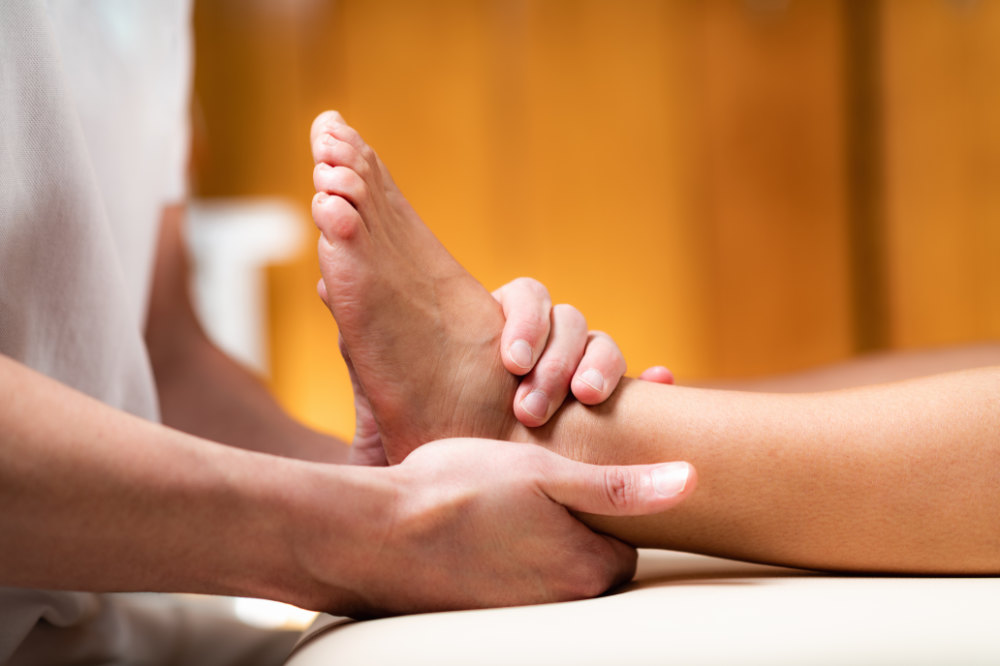
Achilles Tendonitis
More accurately called Achilles Tendinopathy, this is a type of overuse injury in which inflammation is not a big factor. With Achilles Tendinopathy, the tendon struggles to repair itself fast enough. You feel pain either directly on the heel or just above the heel where the tendon joins the calf muscles. You might feel the tendon is thicker in this area compared to the other side, or you might find a small nodule. Nodules come from poor collagen organisation as the injury struggles to heal. This happens when the tendon is being stressed more than usual. For example, rapidly increasing running distances, increased hill running, overtraining, or poor footwear. Biomechanics can also play a part if you have poor knee, hip or ankle stability, or chronically weak muscles/tendons in the first place.
How to Treat Achilles Tendinopathy
Fortunately, tendinopathies can be treated successfully. Recovery is faster when the injury is managed correctly at an early stage. Initially, there will need to be a period of rest followed by progressive and very specific strengthening exercises. Then the underlying biomechanical issue should be addressed – a vital part of prevention. Continuing to run/jump/overwork your tendon can lead to irreversible changes, degeneration and weakening of the tendon, and is a precursor to a full tendon rupture!
Sprains
Ankle sprains and foot sprains are one of the most common types of injuries. Most active people will have rolled their ankle a few times in their lifetime. It can take quite a while to recover. Each sprain will reduce the amount of stability, making it more and more likely that you’ll sprain it again. And this can lead to chronic ankle instability.
A serious ankle sprain can overstretch the ligaments and can sometimes stretch the tendons around it. The more they stretch, the less stable your ankle will be. Properly diagnosing and treating an ankle sprain in a timely manner is vital to avoid long term complications, re-sprains, and chronic ankle pain. Your rehab will include a lot of strength and balance work to regain proprioception which is absolutely vital for a strong and stable foot.
Heel Pain
Heel pain can have a variety of causes and they all need to be treated specifically. Your pain might have crept up gradually, or might be after an impact or a sprain, but either way, it can be one of the most annoying places to hurt. Possible causes of heel pain include stress fractures, heel spurs, bursitis, or a ruptured fat pad, but by far the 2 most common causes are Achilles Tendinopathy and Plantar Fasciitis.
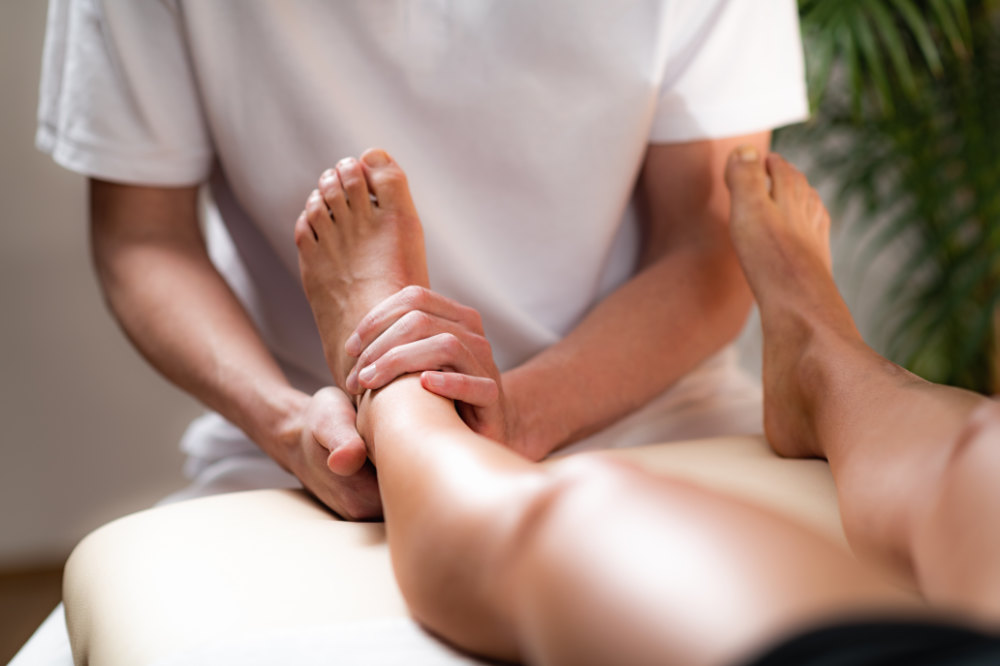
Trapped Nerve
A trapped nerve can happen in any part of the body. The following are the most common kinds of issues caused by trapped nerves in the foot or ankle.
Tarsal tunnel syndrome
In this painful condition, the Tibial Nerve is compressed and irritated as it goes into the foot. It runs down on the inside ankle, between your ankle bone and another smaller bone, and is held in place by a big ligament – creating a kind of tunnel that it passes through (hence the name). This nerve can get compressed from injuries, such as sprains or fractures, or it can happen over time.
Flat-footed individuals are at risk because the outward tilting of the heel can strain the tarsal tunnel and put pressure on the nerve. Typical symptoms of this nerve entrapment are tingling, burning, pain or pins and needles. Usually, this is felt on the inside of the ankle or the bottom of the foot.
Plantar nerve entrapment
This issue is less common than other trapped nerves and can feel very similar to plantar fasciitis. The main difference is that nerve pain tends not to improve at rest and can increase intensity at night. There is usually chronic burning heel pain which is made worse with stretching and standing.
Morton’s Neuroma
A unique and fairly common condition which is often described as feeling like you have a stone in your shoe. This is caused by a small growth around a nerve between your 3rd and 4th toe, just below the point at which your toes separate from the rest of your foot. Whilst this condition can be quite uncomfortable, it is rarely painful. It’s more likely to affect women as it is often caused by compression of the nerve by tight narrow shoes or high heels.
Gout
Gout is a pain kind of arthritis that can affect any joints (but usually the big toe). It will come on quite quickly and present itself as swelling, redness and extreme tenderness in the affected area. It occurs when the body has excess uric acid in the blood causing tiny sharp crystals to form in and around joints. Usually the body will absorb uric acid naturally, but diets high in red meat, seafood, organ meats, and alcohols such as beer, can increase the uric acid levels.
Other risk factors include obesity, kidney disease, untreated high blood pressure, family history, and being a male age 30-50. Those who are disposed to it can have repeated attacks over the years. Each of which might last anywhere from a few days to a few weeks. Prevention is much easier than treatment for this condition as it usually relies on anti-inflammatories and allowing the uric acid crystals enough time to be re-absorbed by the body.
How do Osteopaths treat foot pain?
It should go without saying that the most important element to treating the foot and ankle is getting the right diagnosis! Most conditions have very specific needs when it comes to recovery, but there are a number of things that an osteopath will usually consider regardless of the type of injury:
- Movement: Does the foot move like it should? Does it move too much? Simple questions give us big clues about how your joints and muscles will are functioning. A hypermobile joint might mean instability or indicate previous sprains. A restricted joint could be a result of a dysfunction in your gait. Knowing how your joints move gives us an idea of which parts have been under increased load. We can then use a range of techniques including gentle manipulation (cracking) to increase mobility, or alternatively help you strengthen weaker areas.
- Muscles: In the ankle, muscles play a vital role in balance and stability; they make the micro-movements to keep us standing upright. But these muscles are prone to injury whenever the foot or ankle is injured too. We use a combination of soft tissue techniques, cupping, dry needling, and stretching, as well as using exercises to build strength and balance.
- Compensation from other areas: Issues further up the leg can cause real issues for the foot. For example, a hip rotated outward makes it nearly impossible to walk naturally. Ultimately, it’s your foot that has to take make the compensation because it’s the only contact point to the ground. With most foot/ankle injuries, osteopaths check the knees, hips, pelvis and lower back as well.
- How you stand: Looking at how you stand or walk is a great way to see how your body functions as a whole. Biomechanical issues can be hard to spot when you remain still so your osteopath will ask you to do a range of movements and see how the leg integrates and works together. The aim is to take any unnecessary pressure from the injured area by ensuring you are moving biomechanically as well as possible.
- Your day-to-day life: The goal is to get you back to doing what you love as quickly as possible. So osteopaths will always try to find a way to keep you active through your recovery. This might be through certain activities, specific rehab exercises, or even modifying existing activities to help you avoid aggravating your injury. Your osteopath will advise on the best way to continue working and how to avoid making your injury worse by doing so.
The post Osteopathic Treatment For The Feet – Does it Work? appeared first on MetaMed.
]]>The post Osteopathic Treatment For Babies – Safe and Effective Treatments For Newborns & Toddlers appeared first on MetaMed.
]]>Many people think that because a newborn is so young, that surely they cannot have any muscle tension or pain! However, the childbirth process is a stressful experience for both mother and child. As the child exits the birth canal, an extreme amount of force is placed upon him/her to fit through a narrow gap. To allow this to happen, the skulls of newborns are flexible, having not yet fused together. Multiple fontanels or soft spots in the skull allows the bones to overlap as baby passes through the birth canal. Additionally, the baby has to twist and turn while it passes through the body pelvis. Every now and then a baby may have lasting strains and joint restrictions from this process, with tension in their head and neck that results in abnormal head shapes, pressure in the skull or head favouring. Likewise, other areas may also be affected, including the shoulders, back, stomach and pelvis as well as their digestive system
Commonly treated issues include
- Deformational plagiocephaly aka abnormally shaped head from head favouring towards one side, leading to the baby laying its head on one side and in the same position or a prolonged labour
- Muscular torticollis – aka twisted or wry neck
- Breastfeeding/feeding/latching difficulties
- Reflux
- Sleep disturbances
- Unsettled, restless, colicky babies
- Nasolacrimal duct obstruction – aka eye discharge
- Constipation and/or diarrhoea
- Checking for age-appropriate reflexes and hip function
Osteopathic treatment – what does it involve?
Newborns and toddlers respond much faster to treatment than adults. Their muscles relax and their nervous systems calm down quickly, with a very light touch. For this reason, treatment is subtle, gentle and definitely doesn’t feel like a massage that an adult might get. On average, a child will only need to see an osteopath for 2-6 treatments and benefit from long-term results, however, this depends on the reason and cause of the issue and the age of the child.
This gentle treatment will involve looking over your baby so we can check for hip and back alignment and assess mobility. It’s best if your baby is fed and somewhat settled before the appointment – keep this in mind when choosing an appointment time.
Treatment aims to reduce any muscular tensions found, whether this is in the hips, back, shoulders, neck or head. To do this, light soft tissue massage and balancing techniques are used, as well as rhythmic movements to free up joints. No joint clicking/cracking is done to newborns or toddlers in osteopathic treatment.
Babies cannot directly tell us about their discomfort, instead, they may cry, not sleep and be generally unsettled. Osteopathy can help babies with any physical discomfort, allowing them to really settle into their surroundings. Osteopaths can also help to screen for tongue tie and hip issues, teach you some handy settling techniques and advise mum and dad on best ways to hold/breastfeed for her own comfort.
We can also help with training you how to massage and treat your child, what pressure to use and massage techniques to help with self-care at home.
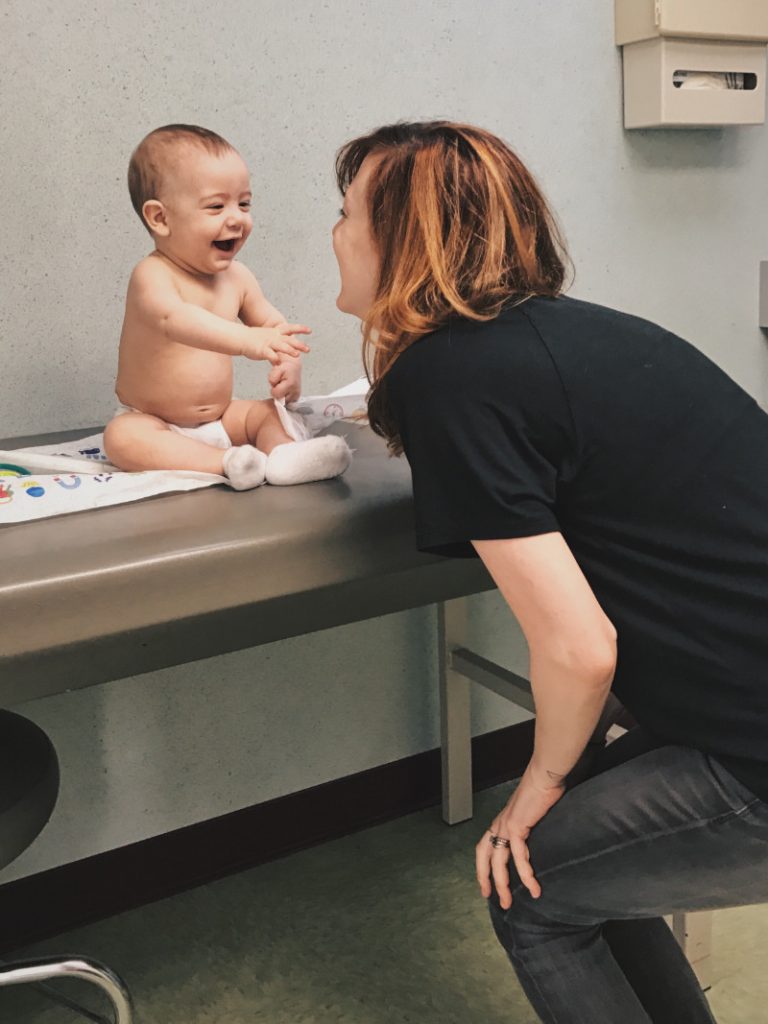
Cranial Osteopathy
Cranial osteopathic treatment is a gentle yet effective treatment approach that provides long-term results. Cranial techniques usually involves gentle touch to feel the body’s natural involuntary rhythm created by the flow of cerebrospinal fluid through the body’s tissues. There can be areas in the body where the tissues do not move as freely and the movement is “stuck”. With a very light touch, the circulation of the cerebrospinal fluid can be affected and improved, restoring healthy fluid movement to the tissues and bringing balance and ease, which promotes the body’s own self-healing mechanisms to restore health and wellbeing.
Although cranial treatment can be useful for people of all ages and builds, babies benefit greatly from early osteopathic treatment. It is a common belief that babies and children should have no structural strains in their bodies as they are too young to have experienced these, however this is not always the case. Babies are often much more settled following treatment as they are grateful to have the stresses of birth and the position that they were in during in-utero released and removed.
An osteopath who is credited with being one the founders of cranial osteopathy said “as the twig is bent so the tree will incline” (WG Sutherland). What this mean is that if there is a strain that occurs during the early stages of one's life, the body will adapt around this and will grow in
Cranial treatment is suitable for all babies and children and can address a variety of conditions and symptoms.
Before and after treatment
Ideally, your child will be fed and settled prior to treatment. After treatment, you may not notice changes immediately, as the body takes time to adjust to treatment. Much like when adults get osteopathic treatment or a massage, babies may also feel more sleepy or irritable for a few hours afterwards.
Reactions to osteopathic treatment are variable. Often the baby or child is very relaxed afterwards and sleeps well. Other children have a burst of energy following treatment, and then usually sleep well after this. Occasionally, babies are unsettled after treatment. This is temporary and can be due to restrictions not having been able to be fully released if they are severe. Additionally, some babies are just unsettled following treatment as Cranial Osteopathy can feel different from anything they’ve ever felt before.
How many treatments will be needed?
On average two to six treatments are usually enough. This does vary according to the severity of the problem and the age of the baby/child. The younger they are, the less treatment it usually takes. We will be able to give you a better idea of the number of treatments that will be required after talking to you and following the initial treatment.
Mums and Bubs duo appointments
At Metamed we offer Mums and Bubs 60min duo appointments which are ideal during the first 3 months postpartum. This provides ample time to give both baby and mum a treatment after the marathon of birth.
These appointments are excellent for addressing any strains or structural restrictions that a baby might be carrying post-birth, whether it was a difficult birth or not. Helping to ease common complaints such as sleep disturbances, reflux and an unsettled baby.
Meanwhile, mum can also get some much needed TLC. Your body has gone through so many changes in a short period of time, from being a pregnant woman to a new mother in 9 months! We adopt so many new positions as a new mum; breastfeeding, rocking baby to sleep, carrying the carseat – all of these can cause pain and discomfort that’s unnecessary.
Our duo appointments are available exclusively with our Osteopath Franca Bauer. Franca combines both structural and cranial techniques, as well as offering support on feeding and latching issues and providing straightforward tips and tricks that you can use at home.
You can book in with Franca at our Wanaka clinic, located at 25a Russell Street, Wanaka 9305. Book online here, or call 03 443 2628.
Appointments available: Monday – Friday 8.00 am – 8.00 pm
How to choose a good osteopath for your baby
Things To Consider When Choosing An Osteopath For Children.
As of 2021, all Osteopaths are required to have undertaken extra paediatrics training at the Ara Institute of Canterbury – if not, they are not allowed to treat anyone under the age of 16.
Other than the required qualifications, a good Osteopath will be fluid with treatment, working with the movements and needs of your baby. Osteopaths that treat babies generally have a soft touch, need to be calm during treatment and confident handling and interacting with babies and toddlers.
The post Osteopathic Treatment For Babies – Safe and Effective Treatments For Newborns & Toddlers appeared first on MetaMed.
]]>The post Osteopathy vs. Physiotherapy – What’s the difference? appeared first on MetaMed.
]]>The Truth About Osteopaths and Physiotherapists
The best practitioner is the one that suits your needs
No two practitioners, whether an osteopath or a physio will approach a problem the same way. There are often many routes to the desired destination. Sometimes the practitioner’s route will resonate with you and sometimes it won’t. So it’s important to find a physio/osteopath that fits well with you, your beliefs and your goals.
There are good and bad practitioners
Just like in any profession, there are good and there are bad practitioners. The key is to find a practitioner that is passionate, is continually learning, uses their time well and supports you to achieve your goal/s.
Know your strengths and your limitations.
Here at Metamed, we work closely with local physios and often refer to each other when we feel another profession will benefit you more. We work hard to nurture this relationship and remove the competition. In Queenstown and Wanaka, we are lucky to have physios that specialise in areas such as concussion, hand therapy, cancer rehab, vocal physio and the pelvic floor (to name a few) that we often refer our patients to.
What are the key differences?
Osteopathy and Physiotherapy are very similar concepts. Both are manual therapies that treat musculoskeletal problems. ‘Musculoskeletal’ refers to muscles, tendons, ligaments, bones, and fascia. Both undertake years of training in anatomy, physiology and pathology.
The level of “Continued Professional Development” required to maintain registration means the skills learned after university continue to blur the lines between Osteo and Physio. Osteopaths will become personal trainers, exercise and movement coaches or specialise in functional movement. Physiotherapists will train in specialised joint manipulations (‘clicks’) and holistic, body-wide approaches.
The biggest difference is the philosophy behind the treatment and why we choose the treatment approach we provide.
Osteopathy
Views the whole body as a unit, which is why when you come in for elbow pain, we might end up treating your shoulder and pelvis. To do this, osteopaths study biomechanics, have a deep understanding of anatomy and consider lifestyle factors that may be contributing. There are four osteopathic principles:
- The body works as a single unit of mind, body and spirit. Which means everything is connected and needs to be considered.
- The body has an innate self-healing capacity – the immune system is pretty incredible we think! Given the chance, with the right encouragement, most injuries will heal. This is what Osteopaths specialise in.
- Structure and function are inter-related and require balance. For instance, if you’re all strength and no mobility/flexibility, movement patterns will change, load will be placed on structures it shouldn’t and injury will occur.
- Prescribed treatment should consider all of these things, and be based on the body’s self-healing mechanism, structure and function.
Physiotherapy
Closely aligned with the medical model of health. The focus is more on the problem area presented and treatment of that area. The Physiotherapy profession prides itself on remaining current with scientific research and works closely with hospitals and medical centres.
Physiotherapists are taught to follow treatment protocols and provide rehabilitative exercise-based treatment. A physiotherapy session may be a lot less ‘hands-on’ than an Osteopathy treatment; instead, the focus is a rehabilitative exercise-based treatment that aims to build you back up to your best after injury.
Frequently Asked Questions
What techniques or approaches do Osteopaths use but Physiotherapist do not?
There are a lot of techniques that cross over between Osteopaths and Physiotherapists. However, Osteopaths and Chiropractors are the only practitioners allowed to manipulate (click) the top joint in the spine. Unless they have done specific training, a lot of Physios won’t manipulate joints at all.
Is Osteopathy better than Physiotherapy?
Despite the differences in philosophy, the aim of both treatments is to help relieve your pain. Both are manual therapies that offer a lot of the same techniques. It all comes down to how they are applied and what works best with your body. For example; some people hate being massaged or having their joints clicked, others never do their exercises or rehab. It all depends on you and your relationship with the practitioner.
Do Osteopaths do massage?
Yes, osteopaths offer massage treatments. There are many different approaches to massage, Osteopaths are taught inhibition, cross-fibre, longitudinal and balanced ligamentous tension release, to name a few. Osteopaths have ‘borrowed’ many techniques from other professions, at times modifying them or their application to work within our philosophy. However, a good osteopath clinic will have developed a close working relationship with a massage therapist and refer to them as required.
Is osteopathy good for back pain?
Osteopathy is great for back pain However, osteopaths treat more than just back pain. Any injury, ache or pain – try an Osteopath and see if they can help.
Can an osteopath help with nerve pain?
Yes, but this depends on the cause. Nerve pain from compressions – such as a herniated disc, carpal tunnel or thoracic outlet syndrome can be helped greatly from osteopathy treatment.
Are both treatments good for pain?
Both Osteopathy and Physiotherapy aim to help relieve your pain.
What conditions does an osteopath work on?
Osteopaths can help with any/all musculoskeletal issues. Any injuries (shoulder, knee, hip, back etc), muscle pain, swelling, headaches, digestive issues, jaw clicking/pain, osteoarthritis, rehab post-injury, tendon issues such as tennis elbow or patellofemoral pain, breathing mechanics, pregnancy-related pain.
Can Osteopaths process ACC like Physios?
Yes! Ther's no need to visit your GP or Physio as osteopaths can process ACC. If you have hurt yourself, osteopaths can lodge an ACC claim. Osteopaths have the same access to specialist appointments and x-ray/ultrasound referrals as physiotherapists.
The only difference is that Osteopaths get 16 treatments subsidised under ACC, while Physiotherapists get unlimited treatments.
Most people don’t realise that one ACC claim can be used with different practitioners, including Acupuncturists, Chiropractors, Osteopaths and Physiotherapists.
The post Osteopathy vs. Physiotherapy – What’s the difference? appeared first on MetaMed.
]]>The post Osteopathic Treatment for Sciatica and Disc Injuries appeared first on MetaMed.
]]>Sciatica is a word to describe the pain felt when the sciatic nerve is compressed, inflamed or irritated. The sciatic nerve is the biggest and longest nerve in the body, running from your sacrum (lower back) down the back of your thigh then branching off into your lower leg and foot.
Sciatica is a symptom often caused by disc injuries or from during pregnancy. Disc injuries = disc sprain, bulge, herniation, rupture, prolapse or a slipped disc. If this occurs the disc may cause increased pressure on the root of the sciatic nerve where it attaches to the spinal cord.
During pregnancy, sciatica is caused by the growing baby taking up space and putting pressure on the sciatic nerve. However, referral pain in pregnancy can also be from pelvis instability – which has nothing to do with the sciatic nerve.
Home remedies that help
We often get asked if there’s any quick fixes or home remedies that help with sciatica. I’ve heard of all sorts of weird and wonderful theories such as putting your feet in boiling hot water… Unfortunately, there’s no quick fix!
Alternating a hot/ice pack, using each one for no more than 10mins, switching out 4 times (hot for 10mins, cold for 10mins, hot for 10mins, cold for 10mins) can help with pain relief and promote healing in the area – this can be done 2-3 times a day.
What do disc injuries feel like?
Pain = sometimes people feel pain in their lower back, sometimes not. Sometimes people have neuropathic pain down their thigh, into the calf muscle, ankle and foot, and sometimes they don’t. Neuropathic pain is often referred to as ‘sciatica’, which is actually a symptom/result of nerve irritation and feels like tingling, numbness or diffuse/hard to place pain.
Onset = most of the time a disc will become painful with a minor, seemingly insignificant movement such as bending down to tie your shoe. However, this isn’t something that has happened ‘suddenly’ but is rather a result of long-term movement dysfunction. Often people are dehydrated or fatigued when they hurt themselves, changing the functionality of your muscles and discs. Disc injuries can also happen after a traumatic injury like a car/bike/ski accident.
Can Discs heal by themselves?
Yes. In the UK, studies have found up to 82.94% of disc herniations spontaneously reabsorb, prompting the recommendation of conservative treatment over surgery (1). “Conservative treatment” involves a combination of things that are specific to the patient:
1. Modified everyday movement – this means taking some time off work – and gradually returning. No lifting, twisting, bending for a while to help settle things down. Follow our active rest regime to reduce inflammation and pain. The timeframe around this stage varies greatly from person to person depending on adherence and injury.
2. Physical therapy – can help reduce nerve irritation, increase local blood flow which encourages healing, get your pelvis and mid-back moving efficiently to offload your lower back and provide pain relief to help you carry out your exercises effectively. And definitely no lower back clicks!
3. Specific exercises – there’s no ‘quick fix’ or ‘magical back healing exercise’ that works for everyone. This is body/pain/lifestyle specific and needs to be guided by your practitioner as you heal.
Can I have a disc removed?
Discectomy and spinal fusions have varied results, which depend on the different surgical approaches, patient rehab adherence and individual spinal health. One review of the available research that included 90 studies found that 22% of patients had worsening back pain at their one-year review and up to 23% had a reoccurring disc herniation (2).
In our clinic, we see spinal fusions place more load on the joints above, over time leading to more disc injuries, this is called adjacent segment disease and provides even more reason to make changes to your movement habits.
The osteopathic approach looks at addressing why your disc injury occurred. We encourage specific exercises to help increase mobility in hips, mid-back and shoulders to reduce the strain placed on the lumbar spine. We also teach individual muscle activation and hip hinging to techniques to improve the efficacy of movement. At appropriate times in the rehab process exercises such as Pilates, yoga, swimming and weight lifting.
Physical inactivity is linked to poor spinal health and low back pain
There are so many great gyms and fitness clubs in Queenstown and Wanaka – find one that suits you and get moving! Boxing, weight-lifting, Pilates, yoga, swimming, whatever you enjoy and makes you feel good! This will help to prevent disc narrowing, high-fat content of back muscles making them weak and reduce the recovery time if you do hurt yourself.
NB: if you are lifting weights and performing squats/deadlifts etc, remember to take your time, get your form and breathing sorted and gradually increase the weight.
Disc injuries can cause debilitating pain and have a costly, drawn-out healing time.
But disc injuries can also be totally painless.
Scans on people with and without back pain have found spinal degeneration and disc damage present in both groups (4). Similarly, those in pain can have a disc injury at a different spinal level to what their symptoms would indicate. Confusing indeed.
After a scan, conservative management is usually recommended initially, with surgery being a last resort.
What’s the benefit of a scan?
Scans should be reserved for the obscure pain presentations that your health practitioner is struggling to identify, or for serious presentations/injuries. Most disc injuries present clearly and are easily diagnosed by your osteopath/physio without needing a scan. However, we find that patients don’t take their rehab seriously until their pain is confirmed by a scan. Resulting in unnecessary scans, clogging up the system and increasing wait times.
Where do I start?
Initially, you’ll likely be too sore to do much. Follow our active rest regime to help reduce pain and inflammation.
Then work on increasing your flexibility in your hips and mid-back and strengthening your core and glutes. If you feel any increased pain in certain movements, stop the exercise and consult your practitioner. The sheets supplied are best guided by a practitioner or trainer.
Be patient! Disc injuries can take up to 18months to heal depending on the extent of the injury.
1. Zhong M, Liu JT, Jiang H, Mo W, Yu PF, Li XC, et al. Incidence of spontaneous resorption of lumbar disc herniation: A meta-analysis. Pain Physician. 2017;20(1):E45–52.
2. Parker SL, Mendenhall SK, Godil SS, Bs S, Cahill K, Ziewacz J, et al. Incidence of Low Back Pain After Lumbar Discectomy for Herniated Disc and Its Effect on Patient-reported Outcomes. Clin Orthop Relat Res. 2015;473:1988–99.
3. Teichtahl AJ, Urquhart DM, Wang Y, Wluka AE, O’Sullivan R, Jones G, et al. Physical inactivity is associated with narrower lumbar intervertebral discs, high-fat content of paraspinal muscles and low back pain and disability. Arthritis Res Ther [Internet]. 2015 Dec 7 [cited 2019 Dec 31];17(1):114. Available from: http://arthritis-research.com/content/17/1/114
4. Brinjikji W, Luetmer PH, Comstock B, Bresnahan BW, Chen LE, Deyo RA, et al. Systematic Literature Review of Imaging Features of Spinal Degeneration in Asymptomatic Populations. Am J Neuroradiol [Internet]. 2015 Apr 1;36(4):811 LP – 816. Available from: http://www.ajnr.org/content/36/4/811.abstract
The post Osteopathic Treatment for Sciatica and Disc Injuries appeared first on MetaMed.
]]>The post Breathing Well appeared first on MetaMed.
]]>Why Learning to do it Properly is so Important
It is something we all do thousands of times every day. Whether we are awake or asleep, resting or active; to breathe is to be alive. Whilst most of us don’t take much notice of our breathing, there are a few very important reasons why we should.
- Improves blood flow
- Improves energy
- Supports a strong immune system
- Alleviates stress
Let's just touch on one of the issues most people have in life and how improving your breathing can help.
Stress response
We’ve all been told at one time or another to “take a deep breath” when we have been feeling stressed. As unhelpful and annoying as this can be at the time, there is some sense behind this.
Our “fight or flight” instinct, also known as our body’s stress response, is how we decide to confront or avoid danger. When we breathe in deeply our lungs expand and compress the walls of the heart, restricting blood flow. To compensate, our heart rate increases stimulating this fight or flight stress response.
When we breathe out, the pressure in the thoracic cavity drops and the body relaxes! So, in short, it is the exhale that truly helps us relax, not taking a deep breath in!
This brings us to an issue we see regularly in clinic – people holding their breath in, or not breathing out fully. It's usually the first change when stress is encountered – holding your breath. Over time if we continue this pattern we can keep our body in the ‘fight or flight' response. Stress and anxiety anyone? No thanks.
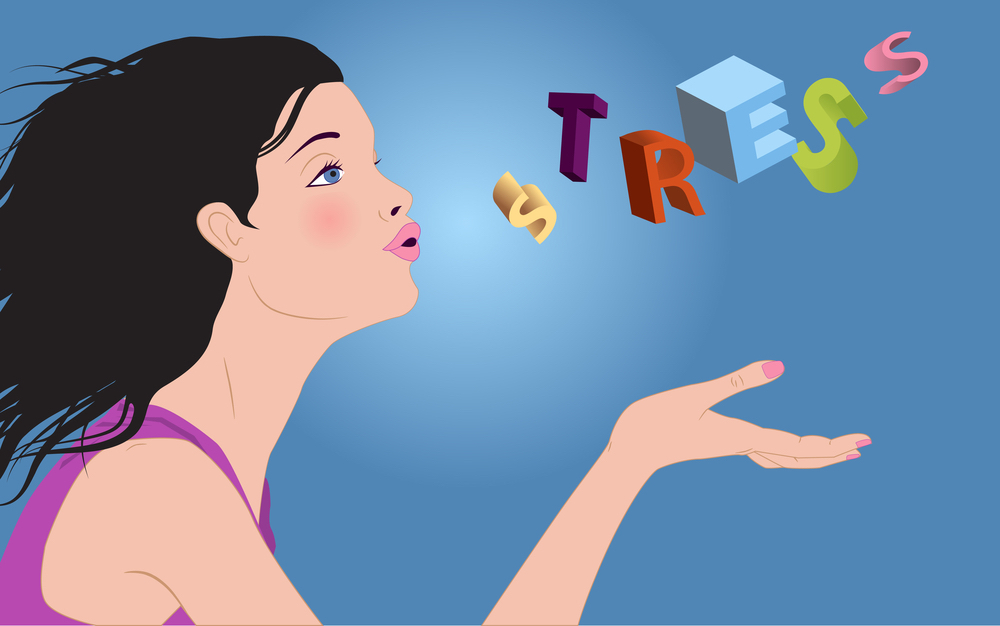
One Simple Trick to Alleviate Stress
Next time you feel stressed or anxious make a mental note of your breathing. Are you holding your breath? Are your lungs full and chest tight? Taking a moment to forcefully exhale several times can make a big difference and quickly reduce the fight or flight response.
Try This Breathing Technique
Inna Kahzan of Harvard medical school recommends that 40% of the breath cycle is for inhaling, and 60% is for exhaling – so for a 4 second breath in, take 6 to exhale. This ensures not only a full exhale, but also slows the breathing, avoiding risks of hyperventilation which can make that stress response much worse.
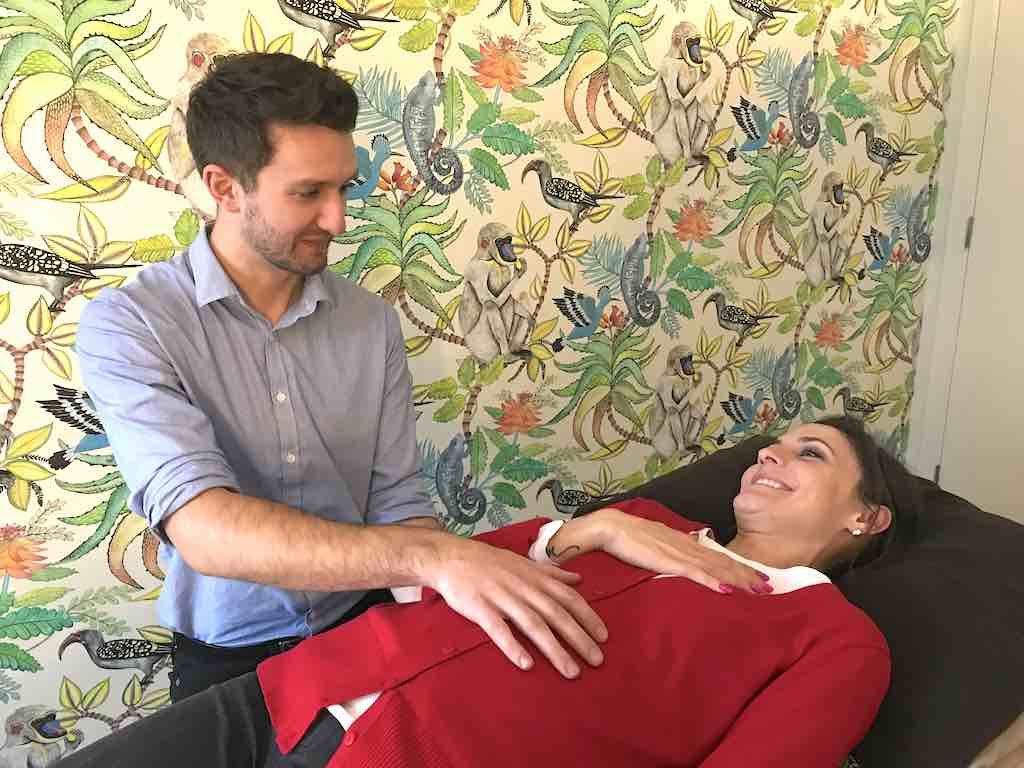
Two Ways to Breathe
- Belly breathing
- Upper chest breathing
While breathing is mostly automatic, every breath is not identical. Diaphragmatic (AKA belly breathing) is best for keeping that stress response to a minimum, but unfortunately the stresses of day to day life can lead us to quickly fall into a habit of breathing into the upper chest. This is not ideal, and aside from typically shallower breathing, it can also cause tightening of muscles in the front of the neck and chest over time. If you catch yourself doing this remember the 40/60 rule and EXHALE for longer!
The stress response/breathing relationship is cyclical, so busy lifestyles often feed into poor breathing patterns. However habits form young, and breathing is no exception either. Some of our cultural expectations, such as the wish to have a flat tummy, means we learn from an early age to hold our stomach muscles in tight.
As I’m writing this, I’m trying to breathe deeply into my belly whilst hunched over my desk (like many who work in an office) – try it, it’s practically impossible. This is another great example of the importance of breathing and taking time away from the desk every so often.

If you know poor breathing habits may be contributing to your pain or symptoms come and visit one of our practitioners. If you're unsure we're more than happy to book in a 15 minute complimentary chat to see if we can help you.
Alternatively, if you're not anywhere near Wanaka or Queenstown we also love Emma Ferris the breathing physio from The Breath Effect. She has a great online course and more information on how to retrain your breathing. Click here to find out more information.
The post Breathing Well appeared first on MetaMed.
]]>The post Are Foam Rollers Worth it? Why & How to use a Massage Roller appeared first on MetaMed.
]]>Is foam rolling good for you?
Using foam rollers the correct way can help increase flexibility, improve joint range-of-motion, relieve back pain, improve blood flow, and help reduce muscles soreness from post-workout DOMS. These are all reported benefits from regular foam rolling. If you’ve been using a roller for a while, you’ll have already noticed the positive changes. You might also be wondering why so many people are torturing themselves in the name of health. But foam rolling should be no more painful than a firm massage. If you grit your teeth as you roll down your IT band for the hundredth time, stop right there. We’ll talk about how to use one properly but for now, let’s look at why you should use a roller.
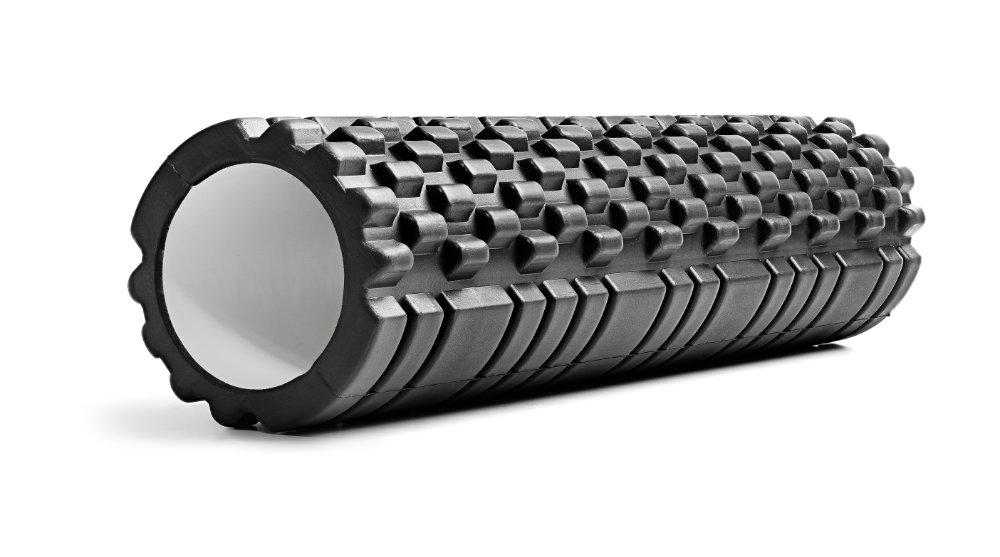
Why should you be foam rolling?
- Flexibility – Foam rolling has been shown to significantly improve flexibility, especially when combined with a typical warm-up routine before exercise (1). And the good news is you don’t need to roll it ‘til it hurts; studies have shown this improvement after just 2 minutes of rolling the specific area (2). So whether you’re looking to work on the flexibility in yoga, or just looking to loosen those stiff joints, reaching for the foam roller is a good idea.
- Performance – When it comes to pre-workout warm-up, you might think back to school days of standing around doing a few static leg stretches. As it turns out, those static stretches actually reduce the endurance and strength of muscles immediately after stretching (3). Not ideal if you’re about to do a heavy set of squats! Fortunately, foam rolling has no such negative side effects! Next time you warm-up for the squat rack, try a few minutes of rolling the hip flexors, quads and glutes and leave the static stretching for after your workout.
- Recovery – Post-workout foam rolling has become a staple for many athletes and for good reason. Foam rolling has been shown to substantially reduce the amount of soreness associated with DOMS and help your muscles recover faster (4). That’s a Win-Win situation.
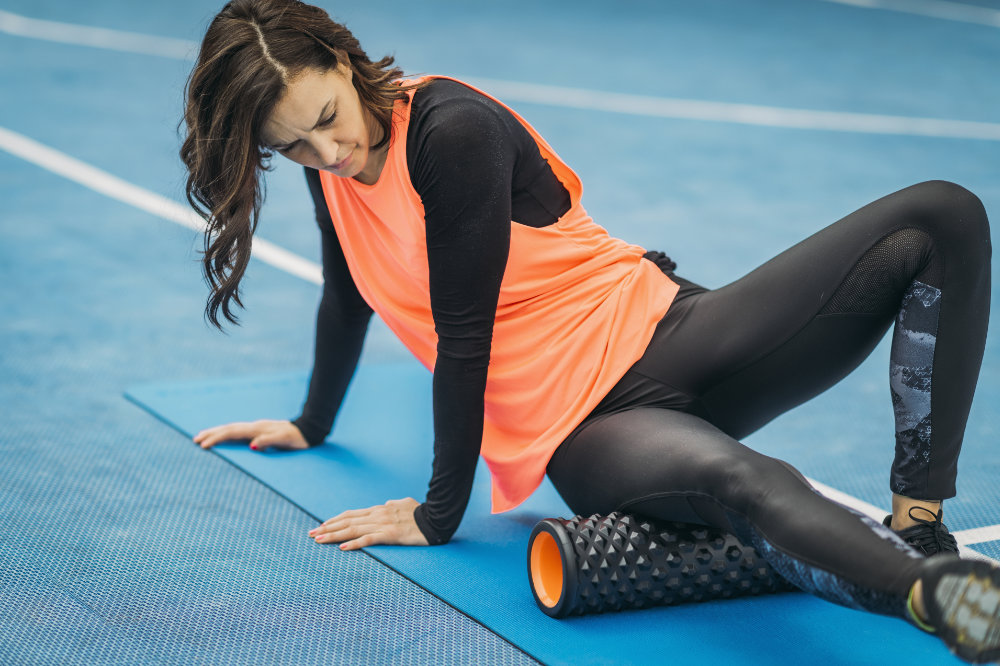
What about back pain?
Mild back pain is often due to overuse or and imbalance of muscles. For this sort of problem, foam rolling can be a great tool to help relieve tightness. However, there are many reasons for back pain and not all of them should be treated with the roller. Figuring out when you should and shouldn’t use a roller can be difficult. The best course of action is to check with your practitioner.
How do I use a foam roller?
This is a really common question. Luckily it’s not hard to learn how to use a foam roller. After consulting with your osteopath, they might recommend you foam target a particular muscle or muscle group. They can show you exactly how to “roll” these areas. (At MetaMed, we have some handy printouts with diagrams in case you forget).
CLICK HERE TO GET YOUR FOAM ROLLER EXERCISES
When rolling any part of the body, there is a sweet spot of pressure for the best results; too much or too little and you won’t get the maximum benefit. All parts of the body are not equally receptive. Some areas can have trigger points or tighter muscles that can feel more painful than others.
We recommend finding a pressure you can work with for 2 minutes. It should allow you to relax. Your muscles will be tight when you begin but should relax by the time you’ve finished. If not, and you’re still feeling discomfort, you might be using too much pressure. In terms of frequency and duration, 3 to 4 times a week works for most people and approximately 2-3 minutes for each area.
I’m a runner, do I need to roll more often than most?
Runners will benefit from around 3 times a week but avid runners doing long-distance training might want to get an extra rolling session done. Pay attention to the IT band. Many runners live in fear of IT band syndrome. This painful condition affects the knee and sometimes the hip. Pain is felt when the IT band rubs over bony areas, causing inflammation during the running motion. The syndrome is often associated with tightness of the IT band. In the early days of foam rolling, this thinking led to runners spending hours a week rolling up and down this painful band of tissue.
While more rolling may sound like a good idea, the reason we call it a “band” and not a muscle is because it’s simply not a muscle. In fact, it’s technically a tendon. And tendons can’t be stretched. If you’re worried about ITB syndrome or already have it, there are ways to address it without torturing yourself on the roller!
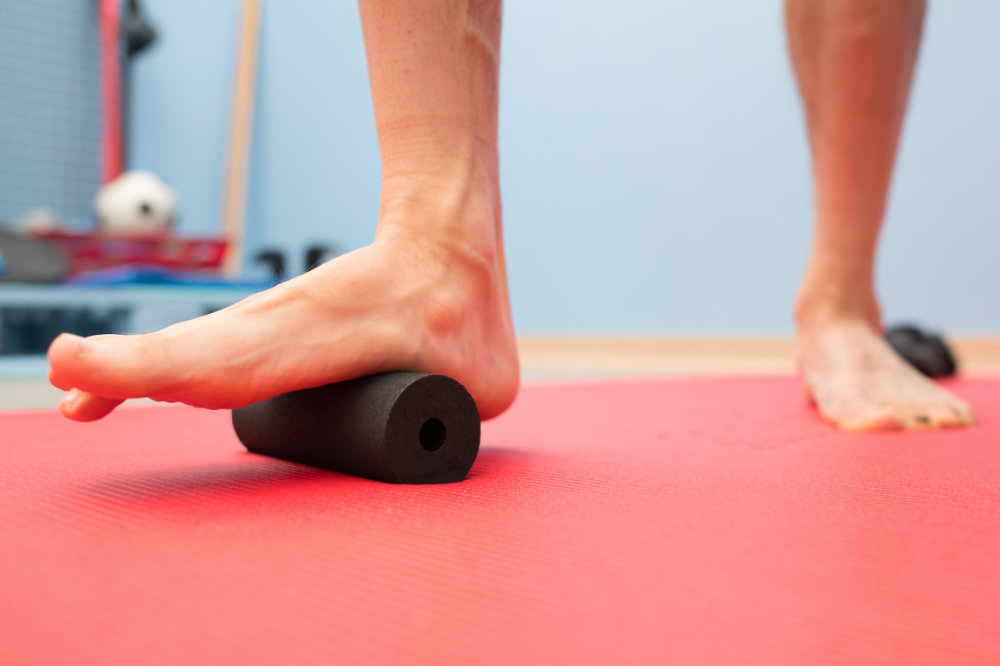
What kind of roller do I need?
Foam rollers come in a variety of sizes, textures, and densities. Like most products these days there is an abundance of choice. We recommend picking a medium-soft one for beginners with a relatively smooth surface. Experienced users might prefer firmer ones that can come with spikes and nodules that help get into the hard-to-reach places. Note that these products can be seriously uncomfortable for the majority of people.
Is there anything I should watch out for when using my roller?
On the whole, foam rolling is a very safe practice provided it’s used carefully. Roll muscles only. Avoid bony bits, rolling over joints, or the site of a recent injury. If it’s really sore or painful, stop and ask us about it!
- Mohr, A., Long, B. and Goad, C. (2014). Effect of Foam Rolling and Static Stretching on Passive Hip-Flexion Range of Motion. Journal of Sport Rehabilitation, 23(4), pp.296-299.
- MacDonald, G., Penney, M., Mullaley, M., Cuconato, A., Drake, C., Behm, D. and Button, D. (2013). An Acute Bout of Self-Myofascial Release Increases Range of Motion Without a Subsequent Decrease in Muscle Activation or Force. Journal of Strength and Conditioning Research, 27(3), pp.812-821.
- NELSON, A., KOKKONEN, J. and ARNALL, D. (2005). ACUTE MUSCLE STRETCHING INHIBITS MUSCLE STRENGTH ENDURANCE PERFORMANCE. Journal of Strength and Conditioning Research, 19(2), pp.338-343.
- Lane, J., Kripaitis, D. and Spina, M. (2017). The effect of Foam Rolling (FR) on recovery from delayed onset muscle soreness. Physiotherapy, 103, p.e46.
Foam roller
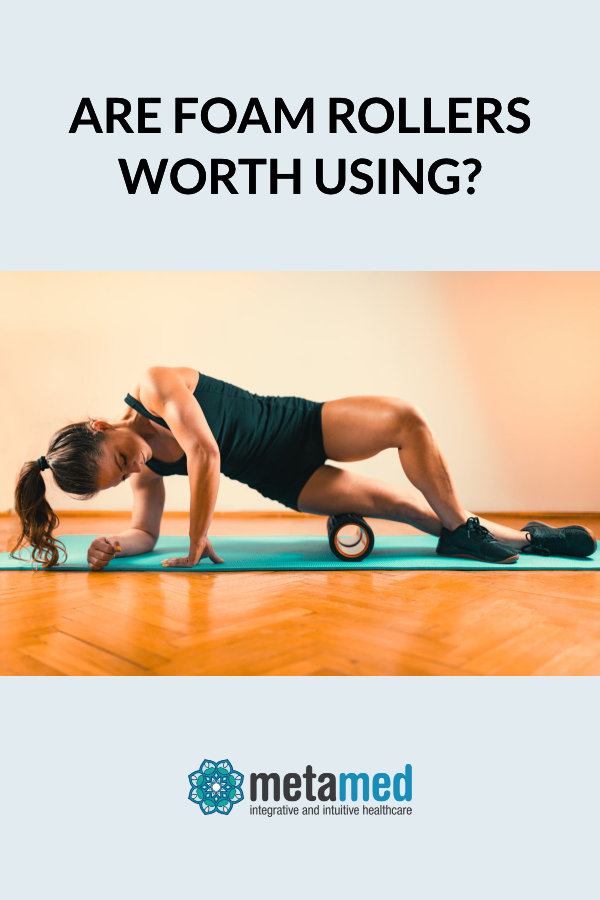
The post Are Foam Rollers Worth it? Why & How to use a Massage Roller appeared first on MetaMed.
]]>The post Plantar Fasciitis Treatment: Your Options in New Zealand appeared first on MetaMed.
]]>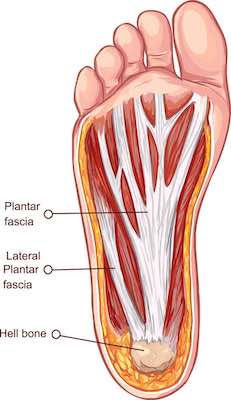
Plantar fasciitis is a unique repetitive strain injury affecting people from all walks of life: runners, walkers, even people who have to stand on hard surfaces at work especially on concrete floors.
For some, plantar fasciitis can be resolved in a matter of weeks, for others it can be one of the most stubborn and frustrating conditions out there. Part of the problem is that it is still a bit of a medical puzzle.
What are the symptoms?
Most people first notice a tightness or a pulling sensation in either the arch of the foot, the heel or both. This can quickly become a very sharp pain felt in the heel, and often much worse in the morning, or when standing up after having been sitting for a while. You might find the foot eases a bit as you walk around, especially in the early stage, but as it progresses, you might find that any weight-bearing on your feet is pretty darn horrible!
What aggravates plantar fasciitis?
The causes are not particularly straightforward. Whilst there will be some of the inflammation in the early days, plantar fasciitis is not a chronic inflammatory condition, despite what the name implies (“-itis” usually means inflammation).
It’s a bit like tendonosis crossed with some degeneration of the plantar fascia. It’s an overuse injury, and it’s common in runners (and menopausal women). Plantar fasciitis is caused by too-much repeated load on the arch of the foot leading to tissue fatigue, but biological and biomechanical factors are also involved. Not everyone who runs a lot will suffer from it.
The plantar fascia is like a web. Or to think of it another way, it’s like a bowstring (with the arch of the foot being the bow itself). Along with a few muscles it supports your foot mechanics and helps maintain the shape of the foot and allows it to be “springy” – very important for running. Too much stretch and it can stretch out and fatigue, too little and it won’t be able to absorb the forces from the ground very well; either way it won’t cope with the strain!
What’s the best way to treat plantar fasciitis?
Plantar fasciitis is a sore and incredibly frustrating condition to have. The good news is over 95% of people will recover with conservative treatment alone. This treatment will usually include a combination of manual therapy, stretching regimes, short-term use of anti-inflammatory drugs, and lifestyle/activity modification.
Surgical options that involve cutting part of the plantar fascia are generally reserved for the most severe and chronic cases. And this is why it’s important to see a professional quickly if you think you might be developing plantar fasciits. Do not wait until it becomes unbearable!
Can an osteopath help with foot problems?
Osteopaths assess the biomechanical components and the lifestyle factors that contribute to plantar fasciitis. They look at your day-to-day life, your footwear, your foot posture and stability, and your gait. The number priority one is reducing the load through the arch of your foot. An osteopath might recommend wearing a supportive shoe with good cushioning as your regular daily shoe – especially if you usually wear flat shoes, high heels or jandals.
It's common with plantar fasciitis that the issues aren't actually in the foot, but higher up, such as weakness in the hips that causes more strain on the foot.
If you’ve got a high arch, then it’s often good to get some orthotics for your shoes. Podiatrists can help you source insoles specifically made for your foot. With your footwear taken care of, you’ll probably have to make a few changes to your daily routine. This might mean taking a break from running for a while or taking the weight off your feet if you stand all day. If the pain is acute and it needs a little extra support, taping is another way to take the pressure off the medial arch.
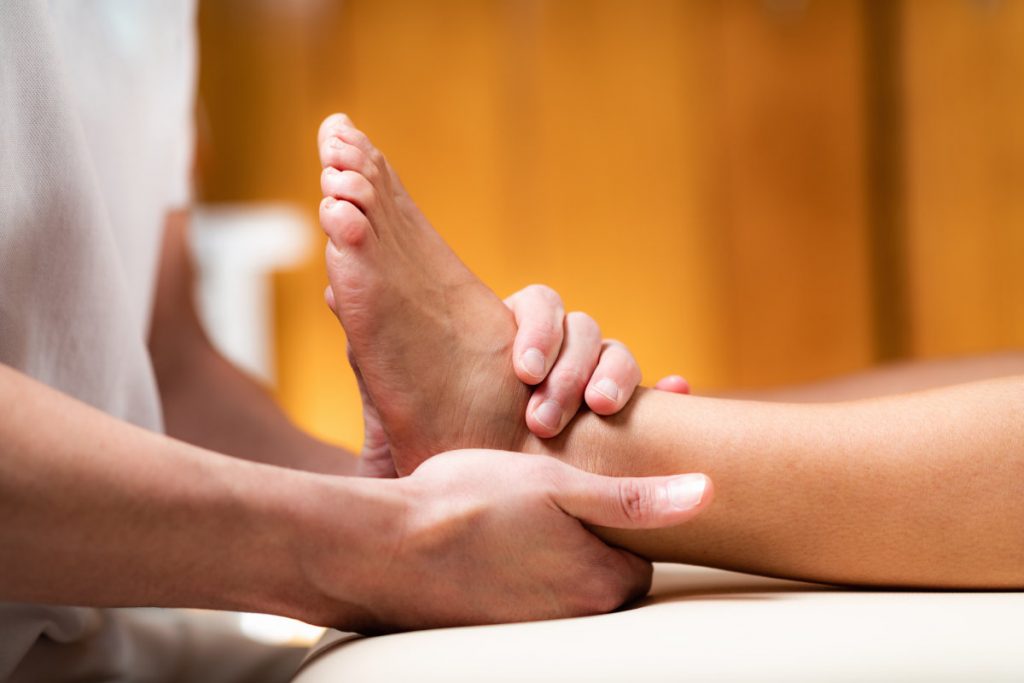
How to Treat Plantar Fasciitis
At home, icing the sole of the foot can feel great and can help relieve the immediate soreness. Freeze a bottle filled with water and roll the sole of your foot gently over it for 15-20 minutes. Repeat as necessary.
Stretching exercises are a vital part of medium-longer term management but won’t offer the immediate relief that icing will. But this doesn’t mean you should avoid them! Stretching of the calf is recommended. And sometimes the hamstrings and other parts of the lower limb benefit from stretching.
CLICK HERE FOR YOUR BASIC PLANTAR FASCIITIS CARE
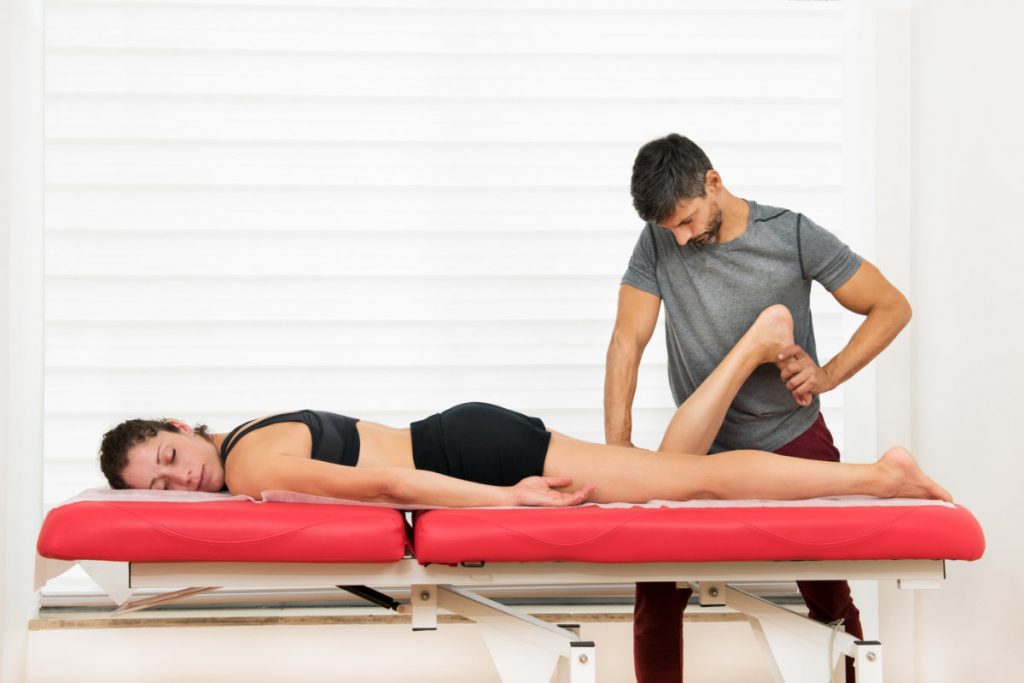
Stubborn plantar fasciitis
Sometimes you can do everything right and still feel as if you’re getting nowhere (I did say it’s a bit of a medical puzzle!) If you’ve been managing your pain properly for 2 months or more but you still see little change, it’s worth looking at Shockwave therapy. Extra Corporeal Shockwave Therapy, to be precise. This is a relatively new form of treatment used for tendinopathy and myofascial conditions.
Shockwaves are high energy soundwaves produced underwater with a high voltage explosion and evaporation – sounds pretty cool right? The theory is that the shockwaves induce neovascularization at the bone-tendon junction and stimulate the release of growth factors to help with cell proliferation. In other words, they improve blood supply and tissue regeneration (1).
While these machines have been around since the 80s, it’s only recently that they’ve been applied to tendinopathy and myofascial issues. The evidence is still growing but is very promising.
1. Dedes, V., Stergioulas, A., Kipreos, G., Dede, A., Mitseas, A. and Panoutsopoulos, G. (2018). Effectiveness and Safety of Shockwave Therapy in Tendinopathies. Materia SocioMedica, 30(2), p.141.
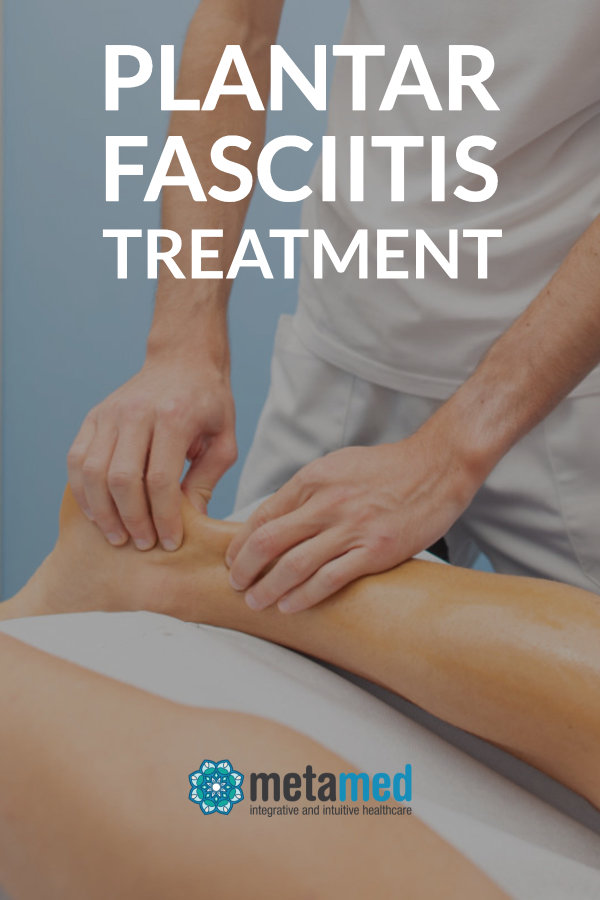
The post Plantar Fasciitis Treatment: Your Options in New Zealand appeared first on MetaMed.
]]>The post How To Prevent Muscle Cramp appeared first on MetaMed.
]]>Cramp develops when you have an involuntary over contraction or sustained muscle contraction. Either way, it's a pain in your life that you don't need.
What Do Normal Muscles Do?
Normally muscles are constantly contracting and relaxing (shortening and lengthening). Signals from nerves into the muscle tell it to contract, and signals feeding back to our spine and brain then send signals back out to the muscle to relax. The constant process keeps the muscle at a nice resting tone, not too tight and not too loose. This is what we call resting muscle tone.
Cramp Is Like A Short Circuit
You could see a cramp as a short circuit in the system where nerves signaling to the muscle are telling it to contract more and more, but the feedback isn't there for messages to be sent back to the spine and brain to send new signals out to tell the muscle to relax.
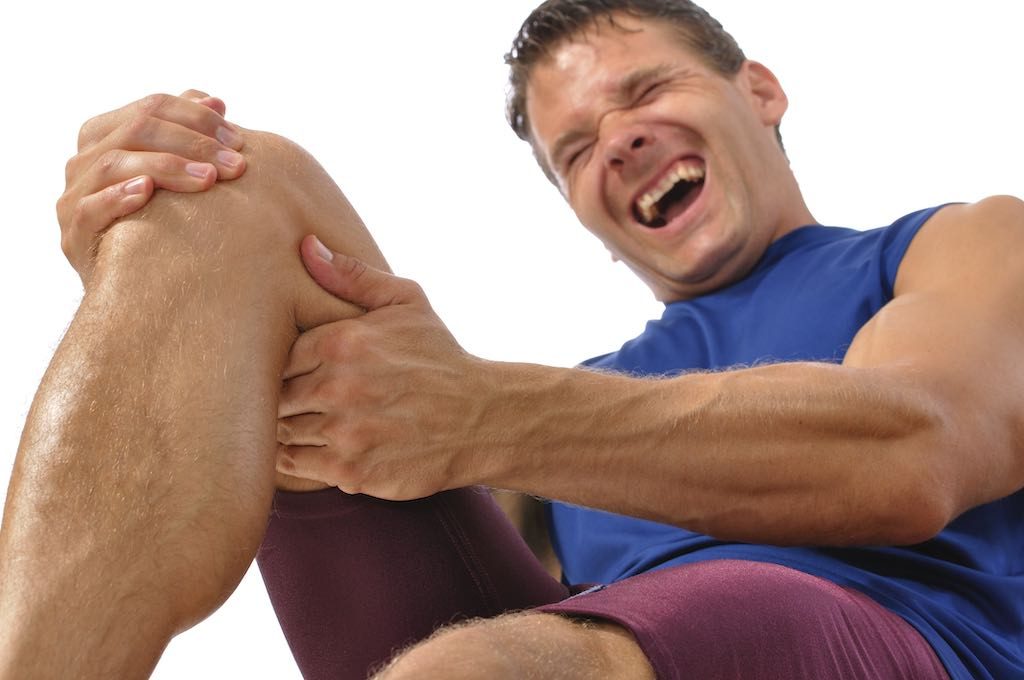
What Does Cramp Feel Like?
Cramp is different from a tight and sore muscle. It's usually a very strong contraction. It commonly occurs in the calf, but any muscle can be affected, fingers, toes, shoulder, quads, etc…
You may feel your muscles harden, toes curl and then you feel like you’ve been punched in the muscle for the rest of the day. A severe cramp can cause involuntary movement of fingers and toes or make you rigid with the pain.
What Causes Cramp?
- Poor muscle conditioning – lack of strength or appropriate training
- Overworked muscles including overtraining
- Lack of stretching – yes, it really does help
- Magnesium deficiency
- Dehydration

5 Tips To Help Cramp
- Drink plenty of water. Add electrolytes if sweating a lot. Amounts of fluid consumption will vary on your age, sex and activity levels. If your pee is dark yellow, you need to drink more.
- Hold your stretches for 2 minutes. Set your timer, it's a long time. See the link for our lower limb stretches below.
- Massage yourself: use your hands, spikey balls or foam rollers. Or we think it's much nicer to get someone else to do it for you.
- Magnesium supplementation. A general dose is 300 mg per day (great to take at night to help sleep and ease cramps that get you when you sleep. In pregnancy, the risk of cramp can be higher and dose can be increased to 350-360 mg per day. For active males, a dose of up to 420 mg can be taken. Have a read of our Magnesium blog about the different types to ensure you get an absorbable form right for you.
- Dry needling. If you've tried all of the above and still experiencing cramp you still have options. We love using dry needling to help ‘reset' muscle tone and nerve input. It's highly effective for relieving muscle tension, especially cramping.
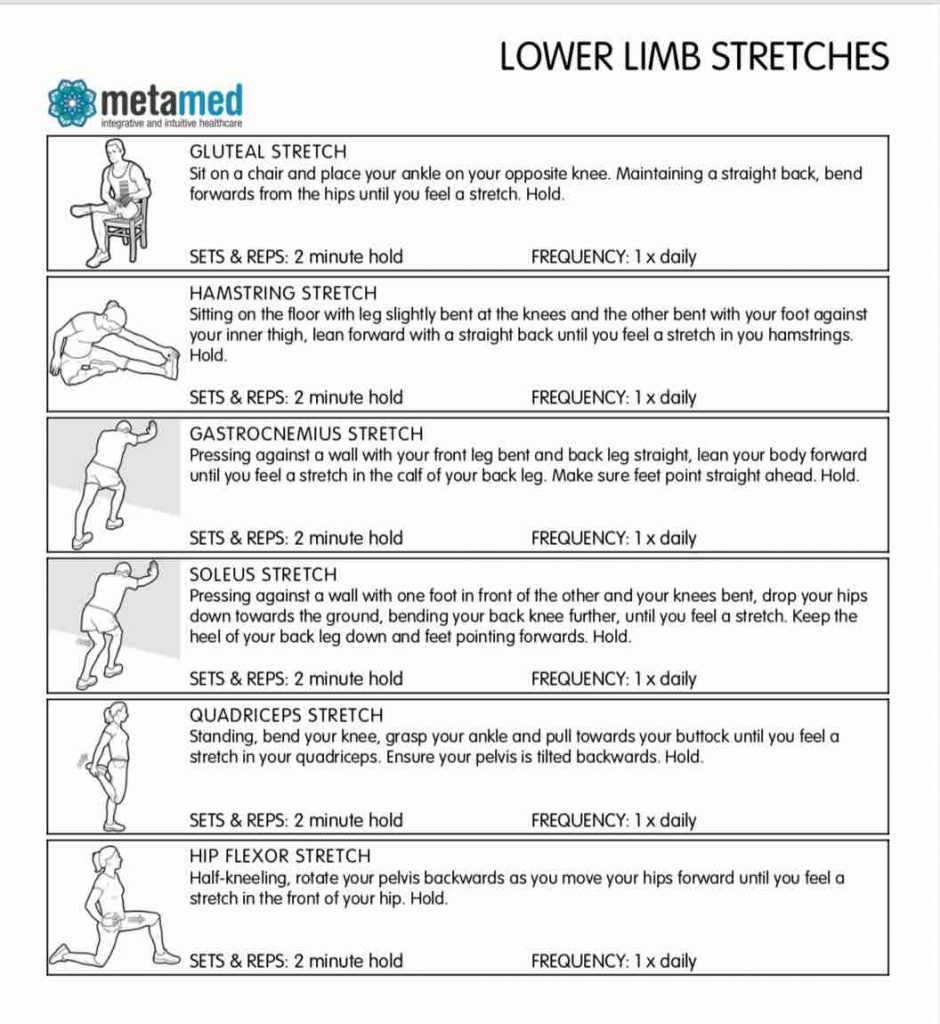
If you're suffering from cramp don't keep waiting for it to get better on its own. Seek help with our holistic practitioners. We have osteopaths at MetaMed Wanaka and osteopaths and chiropractors at MetaMed Queenstown experienced with treating cramp.
The post How To Prevent Muscle Cramp appeared first on MetaMed.
]]>The post Diastasis Recti: What Is It And How Do You Repair It? appeared first on MetaMed.
]]>What is Diastasis Recti?
Diastasis recti is the fancy pants term for abdominal separation. It affects the ‘six-pack muscles' (they are under there!) of your stomach. The anatomical name for your ‘six-pack' is rectus abdominis muscles.
The abdominal muscle separation occurs in both men and women when there is prolonged horizontal stress on the linea alba (line of connective tissue down the middle of your rectus abdominis muscles.
Who Gets Abdominal Separation?
Both women and men can experience a separation of their abdominal muscles. There are a variety of conditions and risk factors that may predispose someone to develop an abdominal separation.

Pregnant Women
Diastasis recti is most commonly seen in pregnant or postpartum women, this is due to the surge of relaxin hormones that help everything to soften. Relaxin allows your ligaments and connective tissue to soften allowing your pelvis to open and accommodate your growing baby and make childbirth easier. It doesn't happen in every pregnancy but this is when we usually see it. It's the common cause of ‘mummy tummy'.
It can happen early in pregnancy or later. It's a good idea to work with a practitioner who commonly works with pregnant women so that they can keep checking if you're starting to develop an abomdinal muscle separation. There are lots of ways you can look after a diastasis to prevent it from getting worse.

Don’t forget the Lads.
Abdominal separation is often missed in men but can contribute to lower back pain. This is why when you come in for back pain we'll look at your whole body to try and work out all the factors you need to address to aid recovery.
We see it lots in farmers and builders. Especially the one with the nice round beer bellies.
Weight gain around the belly area can put extra stress on the abdominal muscles. Pair this with lots of heavy lifting and labor with poor technique over time can lead to separation of the abdominal muscles.
For the men, we often see these many years down the track and it is more challenging to work with, but we can still help. We recommend that if you are in a heavy lifting job that you learn how to use your core properly and take your time with proper lifting technique to prevent it happening in the first place. We recommend seeing a practitioner that understands abdominal separation who can prescribe a specific exercise program that includes core exercises.
For the rest of this article, we'll focus on abdominal separation seen in pregnancy. But guys, get in touch if you think you have this as we can still help you!
How to Detect a Separation
To diagnose diastasis recti a practitioner will feel for a gap between muscles of more than 2cm, further imaging via ultrasound may be used to confirm a diagnosis although not that commonly used.
To test yourself, lie on your back with your knees bent. Supporting your neck with one hand, inhale then exhale and gently lift your neck in an ab crunch like movement. With the other hand, use your fingers to feel in the middle of your abdominal muscles. If your fingers sink in and you feel a gap of more than two fingers, you have a separation.
In more severe cases it may look like doming, bulging, sinking, in the middle of your belly.

What Can Cause It?
It can be hard to tell who exactly is going to get diastasis rectus in pregnancy but there are some things that can make you more likely to develop one.
- Second, third or fourth pregnancy, especially if you had one in a previous pregnancy
- Poor posture of the spine
- Having a weakness of your core control muscles (deep abdominal muscles and pelvic floor)
- Exercising incorrectly during pregnancy
- Lifting excessive loads
What Makes Diastasis Recti Worse?
There is plenty of day to day movements that can make diastasis recti more prominent and prevent healing:
- Sitting up to get out of bed or a chair.
- Getting groceries or strollers in and out of a car.
- Picking up a child.
- Exercises such as plank, sit-ups and squats.
Going back to exercise too quickly post-pregnancy can prevent diastasis repair and can leave you with a ‘pouch’ or ‘mummy tummy' no matter how many crunches you do.
Having an abdominal separation can contribute toward lower back pain, pelvic pain and pelvic floor issues such as incontinence.
If you suspect you have an abdominal separation it's best for you to speak with an experienced practitioner or trainer to learn to modify certain postures, movements and any core exercises or exercise program you do.
Can You Repair Diastasis Recti?
If it gets detected early enough there are definitely ways you can prevent it from getting worse and help restore tension across the separation. This means the gap may still be present but it isn’t so weak anymore. The first six months post-pregnancy is when you have the best chance of improving this.
For pregnant mums, this is where having the right people around you to pick up the signs of diastasis early is important. It may be your midwife, trainer, pilates or yoga teacher, or therapist (Osteo, chiro, physiotherapist).
What Can Help?
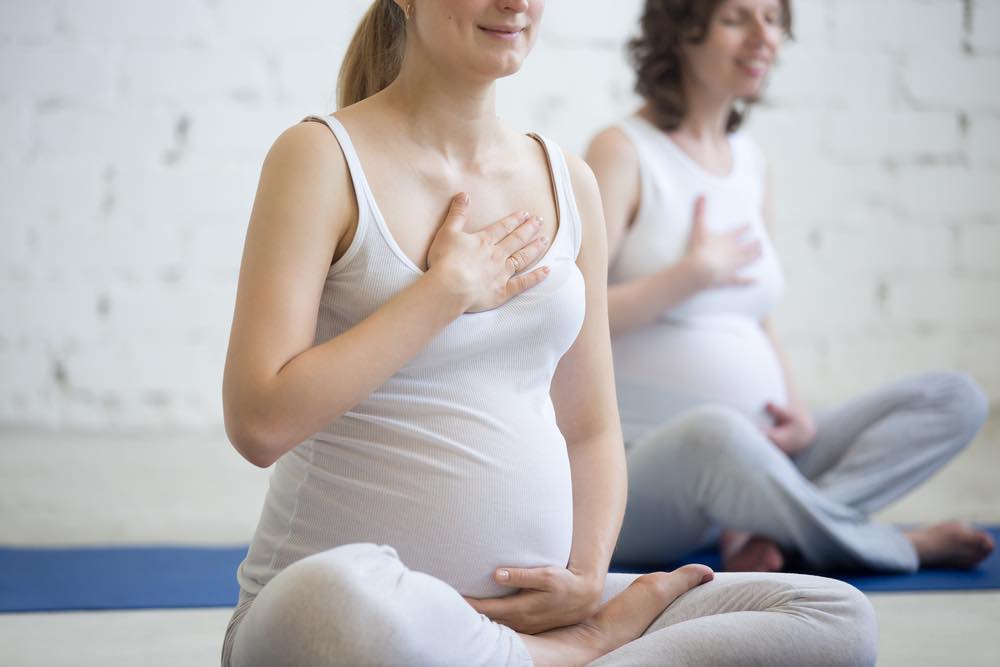
Breathing Properly
The main muscle in-charge of breathing sits underneath the ribcage and is called the diaphragm. Normally, the diaphragm pulls down into the belly, making it rise and fall with each breath. During pregnancy the diaphragm is pushed upwards by the growing uterus and baby, preventing you from getting a full, deep breath.
It’s important to retrain your diaphragm to its full function post-partum as it is an essential part of your core. Spend time each day focusing on ‘belly breathing’ by placing your hands on your lower ribs and expanding them outward, without moving the chest. In for 2 seconds, out for 4-6 seconds. Struggling with this? For more information on breathing click here.
Emma Ferris from The Breath Effect has online classes that can help you out too.

Posture
Postural habits formed during pregnancy commonly continue on post-partum. There are two common postures that require correcting to help repair diastasis recti.
- Some women tend to stand with their pelvis pushed forward, forcing stability to come from muscles in your back and glutes.
- Alternatively, do you ‘hang’ from your hips? Pushing your belly forward and over-extending/locking your knees? This increases pressure on the abdominal muscles and can cause increased curvature of the lower spine ‘sway back'.
Bringing awareness to your posture and focusing on ‘postural stacking’ to align your spine. Try not to arch your back or grip any muscle too tight. Imagine a string is pulling you upright from your head, elongating your midline, spine and stretching your ribcage away from your pelvis.
Avoid Constipation
The act of ‘baring down’ when constipated can significantly increase abdominal pressure and increase abdominal separation. Remember to keep your fluids up, consume plenty (25 grams) of fibre each day and exercise. If this doesn’t work, talk to us about herbal remedies that gently get your bowels moving.
Abdominal Supports
Our friends at Pelvic Solutions, women's health physiotherpists recommend wearing abdominal support shorts (similar to spanx) post-partum to help increase awareness of your abdominal muscles and encourage the muscles to come back together. Ideally, you’d wear the shorts for 6 weeks, however, everyone is different and based on your presentation you might need to wear them for longer. While you’re at it, book in with the team at Pelvic Solutions and get your everything checked!

Non-Aggravating Exercises
There are a few easy to implement changes you can make to prevent ‘belly doming’ in day to day life.
- Avoid sit-up type movements, so roll over to your side in bed and use your arms to push yourself up. This reduces intra-abdominal pressure that may prevent diastasis recti repair.
- When lifting, exhale as you lift rather than gripping on tight. Make sure that load isn't too heavy either.
Pelvic Floor Exercises
Kegels! We all know about them. Pelvic floor exercises can help to strengthen the core as well. But, did you know that many women have an overactive pelvic floor? This means kegel exercises aren't appropriate for you. We recommend seeing a women's health physiottherapist to be assessed and taught how do these exercises properly.
Other abdominal core exercises such as bird dog, heel slides and pelvic tilts can help activate the core muscles without increasing intra-abdominal pressure. Not sure about these? We can help!
AVOID: crunches, planks, squats and any other exercise that increases the pressure in your belly.
Once assessed by a practitioner and given the go-ahead you can start reintroducing ab exercises slowly and gradually.
At-home programs
We also love the MUTU at home post-natal exercise programs which are targeted for a new mum with abdominal separation. They're full of great resources around diastasis recti too.
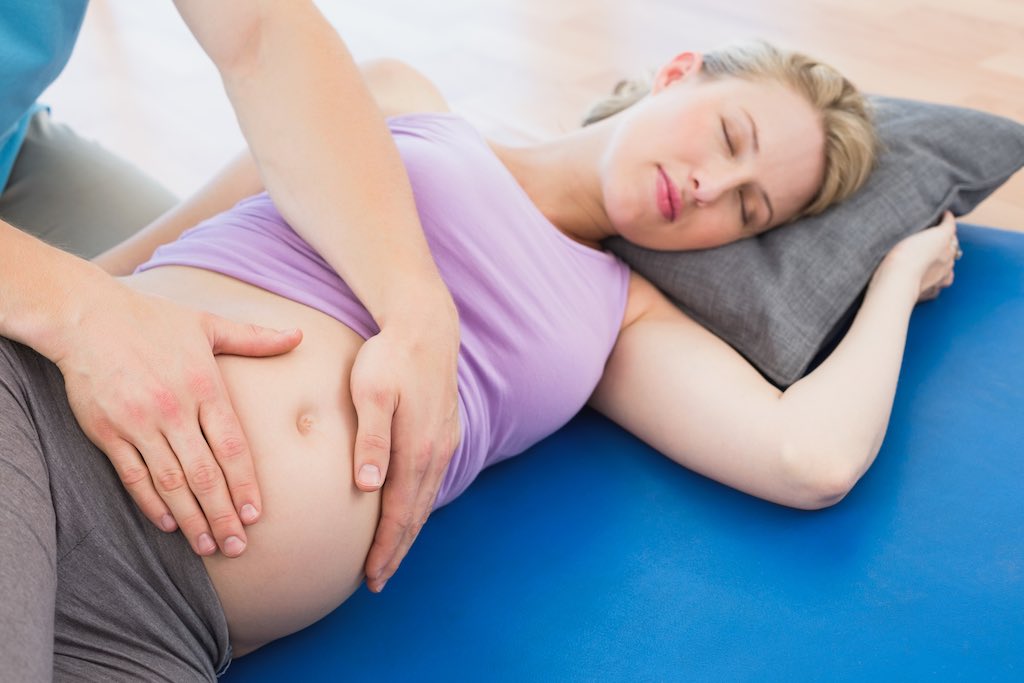
Osteopathy Treatment
Your osteopath can help to diagnose diastasis recti and guide you through the healing stages by advising on the correct breathing habits, postural positions and safe exercises to do. We also love to collaborate with other practitioners and trainers that we know and trust can help you recover and improve your abdominal separation.
As osteopaths we look body wide for compensations in movement patterns and identify any areas that may be contributing to increased pressure on your abdomen. Sometimes you can read all about the issue, but you still need specific and personalised advice to ensure effective healing.
If you are pregnant we also have a great post about what you can do and who you can see at different stages of your pregnancy. Click here to check the post out.

FAQs
Can you fix Diastasis Recti?
Diastasis recti or abdominal muscle separation can be helped.
How do you diagnose Diastasis Recti?
Laying you down, a practitioner will put their fingers over the midline of your stomach (above your belly button). Do a semi sit up. If diastasis recti is present there will be a gap felt greater than one finger wide.
Is Diastasis Recti dangerous?
No. The separation however can get quite large. If a conservative approach doesn’t work (education, postural advice, exercise program and core exercises). This may compromise your ability to stabilise (due to lack of core) and put you at a higher risk of lower back issues. If it is severe you may need a referral to a specialist.
Can Diastasis Recti be painful?
Some people can notice tenderness around the separation particularly around the belly button. More so if there is a hernia present.
What exercises not to do with Diastasis Recti?
You are best to avoid any exercises or movements that cause bulging of the separation or put more stress on the separation. You are best to avoid sit ups or lifting heavy loads.
How do you sleep with Diastasis Recti?
Any position that is comfortable is safe to sleep with an abdominal separation. Just make sure that when you get up from laying to sitting don’t sit straight up. Roll onto your side and use your hands to push yourself up.
The post Diastasis Recti: What Is It And How Do You Repair It? appeared first on MetaMed.
]]>